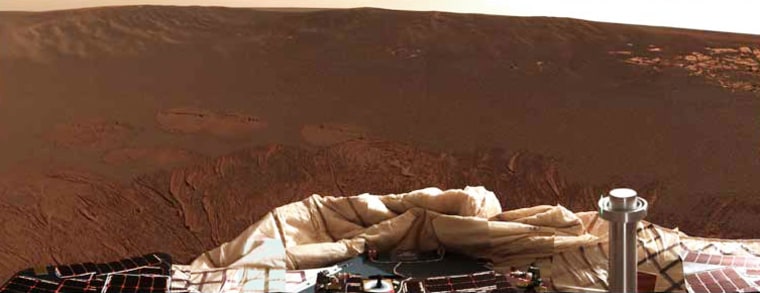NASA’s Opportunity rover sent back a sweeping color view of its surreal surroundings on Mars, and engineers said Monday that Spirit, its ailing twin, may have suffered computer problems because it was trying to keep track of too many files.
As part of a weeks-long process to nurse the Spirit rover back to health, engineers will tell it to delete hundreds of files that accumulated during the spacecraft's seven-month, 300-million-mile cruise to the Red Planet, mission manager Jennifer Trosper told journalists at NASA's Jet Propulsion Laboratory in Pasadena, Calif.
For the first time since the Viking missions of the 1970s, NASA is juggling two separate Mars explorations with the ailing Spirit and the freshly arrived Opportunity. The two rovers are part of an $820 million mission to determine whether ancient Mars had liquid water long enough to support the development of life.
Spirit and Opportunity are in very different places, on opposite sides of the Red Planet: Spirit landed on a flat stretch within 90-mile-wide (144-kilometer-wide) Gusev Crater, which scientists believe may have been a lakebed many millions of years ago. Opportunity came to rest Saturday night within a 65-foot-wide (20-meter-wide), 6-foot-deep (2-meter-deep) crater, on a plain called Meridiani Planum. The plain is interesting to scientists because it has high levels of a mineral called gray hematite. On Earth, that mineral can be formed either through interaction with water or through volcanic activity.
Spirit's glitch
Since its landing on Jan. 3, Spirit sent back thousands of images and moved off its landing platform to begin analyzing Martian rocks and soil. But the spacecraft suffered a serious communication breakdown last Wednesday. Over the weekend, scientists traced the problem over the weekend to a glitch in its flash memory — a file storage system similar to the cards commonly used in digital cameras.
On Monday, Trosper told journalists that Spirit was "doing better." Engineers were working around the flash memory problem by telling the rover to store data in its random-access memory instead.
"It's kind of like we have a patient in rehab here, and we're nursing her back to health," she said.
Trosper said the "too many files" problem was the current leading theory for why Spirit failed last week. She said mission planners had not expected the rover's flash memory to accumulate so many data files during its trip to Mars and investigations on the surface.
"This is a new problem that we've encountered, based on having many files," she said.
During the weeks-long process of reviving Spirit, hundreds of unneeded files from Spirit's cruise phase would be deleted, she said, and controllers would keep a closer eye on memory management for Spirit as well as Opportunity. "We will be more conscious of this limit that we have," she said.
Spirit could be rolling again in two or three weeks, mission managers say.
Opportunity's picture
Meanwhile, Opportunity mission team members said their rover was in fine condition, with "no faults."
Cornell University's Jim Bell, leader of the panoramic camera team, released Monday's 180-degree color "snapshot" of Opportunity's home crater. It was the most detailed view yet of an environment unlike any seen before by a Martian lander.
Bell was intrigued by the unusual mixture of coarse gray and fine red soil, which retained the imprint of the rover's landing airbags and even the seams of those airbags. "The properties of the soil cause it to brighten when it's compacted like that," he said.
He said the chocolate-brown soil was darker than the stuff at the Spirit, Viking and Pathfinder landing sites, reflecting only about 10 to 15 percent of the sunlight.
Bell also marveled at the unprecedented ground-level view of Martian bedrock, which showed up in the snapshot as light-colored outcroppings. "This is like a holy grail for a geologist, to be able to see these incredible rocks that are in their native habitat," Bell said.
What's next?
The six-wheeled Opportunity was due to roll off its landing platform in a week or two, depending on what engineers learn about Spirit's problems. Once it hits the surface, Opportunity would likely take at least a couple of weeks to analyze the soil as well as the bedrock, and eventually drive over the crater lip to study the plain beyond, said Cornell's Steve Squyres, principal science investigator for the rover missions.
Squyres said all of Opportunity's scientific instruments appeared to be in perfect health. That applied even to the Mössbauer spectrometer, a device that is designed to analyze iron-bearing minerals and plays a key role in detecting hematite.
During the cruise to Mars, telemetry indicated that the spectrometer wasn't working the way it was supposed to, but Squyres surmised that the problem was merely due to zero-gravity conditions affecting the device's moving parts.
"It has healed itself, and the thing works perfectly," Squyres said.
NASA has said Spirit and Opportunity would each conduct a primary mission lasting 90 Martian days, or 90 sols, but Squyres said the 90 days was more like a warranty period than an expiration date.
"There is reason to believe that we are going to get significantly more than the 90 sols that we had originally planned for," he said. Also, the science mission was planned with the expectation that there would be 30 days of down time, he said. For that reason, he wasn't worried about Spirit's weeks-long convalescence.
"It doesn't mean that the wheels are going to fall off on Sol 91," he said.
